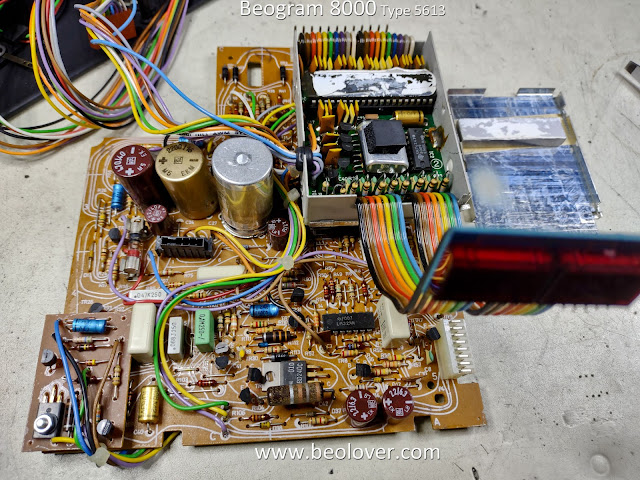In this post I will show some bench measurements of this Beogram 4004.
It has been performing great and it is time to look at what is going on electronically (since I completed all of the electrical work).
I used an oscilloscope to monitor four key control signals. Then I measured the Run-Off Stop circuit signal from the position sensor. Last, I measured what the record detection sensor circuit looks like as measured at transistor 1TR3.
Here is the relative part of the schematic that shows the four control test points I measured.
I wanted to capture those test points for various key Beogram control events (i.e. Start, Stop, Cueing, etc.).
Highlighted on the diagram are four control signal test points (ON, OFF, Cue Down and Cue Up).
Note: B&O changed the wording on the Beogram 4002/4004 control buttons so in some Types there are buttons: ON (<<) and OFF (>>) while on other Types the buttons say START (<<) and STOP (>>).
The diagram also shows 1D41 where I measured the Run-Off Stop signal.
Here are the test point wires connected for making the measurements. It also shows the test point wires for the Record Detection circuit and the Run-Off Stop.
The following three pictures are oscilloscope screenshots for various Beogram 4004 events.
Viewing Tip: If the enlarged photo is too small to read the printed measurements, right-click the photo and select "Open link in new tab" or "Open link in new window". The image in a stand-alone tab will allow you to zoom in for more detail.
In the first grouping I have a reference measurement of the four test points when the Beogram is turned off. Next to it are the signal measurements when the START button is pressed.
Below those two measurements are the signals when the Beogram finds the set down point and lowers to play a record. Last, are the signals when the arm is lowered and playing a record.
The next grouping continues with another picture of the control signals during record play.
That is followed by a cue up (arm raised), pause event.
The third picture shows the signals when the Beogram is operated in Slow Forward and Slow Reverse.
The final picture shows the signals when the Beogram is just paused over a record.
Note that the Cue Up signal is only active when the Beogram is in play mode and is either paused or scanning slowly (forward or reverse). The Cue Up signal is off when the Beogram is scanning fast (forward or reverse) or cued down.

The final grouping shows the signals during the event where the Beogram is operated in Fast Forward mode until it reaches the ES (End Stop) switch and reverses to Fast Reverse.
The picture next to that is the event where the Beogram is in Fast Reverse mode and reaches the SO (Shut Off) switch.
The bottom left picture shows the event where the Beogram is cued down (playing a record) and the STOP button is pressed.
The bottom right picture changes out the ON (<<) TP with the Run-Off Stop TP and shows the Run-Off Stop signal in relation to the OFF (>>) TP.
This photo shows the Beogram 4004 position sensor and scale that generate the Run-Off Stop signal.
This final photo of this post is another oscilloscope screenshot of the Record Detection circuit.
The test point is at the 1TR3 transistor collector and shows the signal generated by the Fixed Arm sensor over an empty platter (after processing through transistor 1TR3).
That is what I want to see. A very healthy signal showing an empty platter. The low part of the signal drops all the way down to zero volts and the peak is around six volts. Very nice.
This Beogram 4004 is performing great and in the next post I plan to wrap up the service manual adjustments.






























